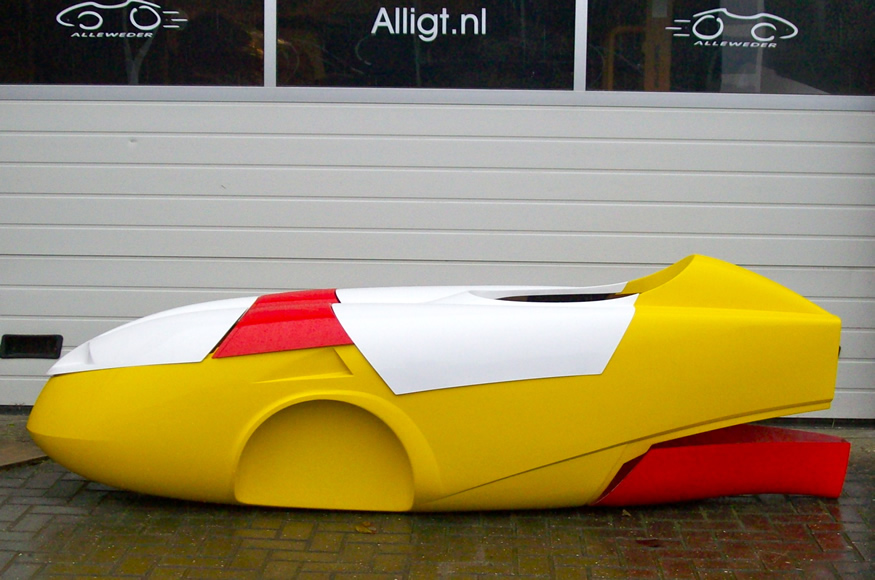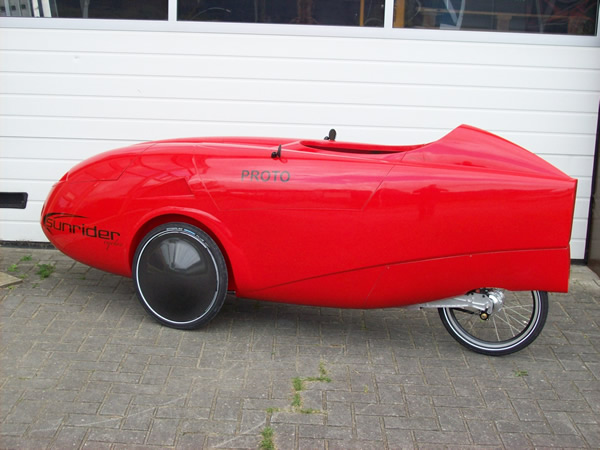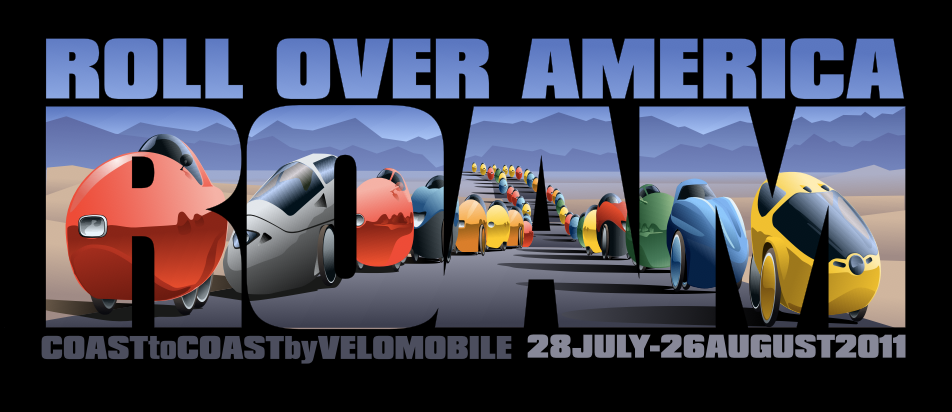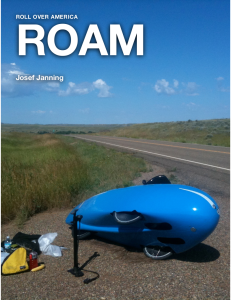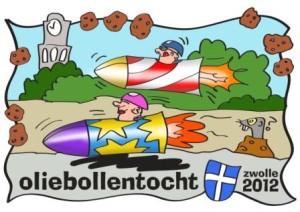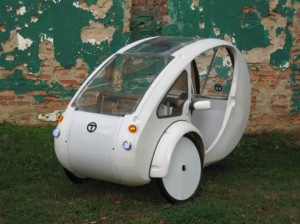 The ELF is a relatively large electric assist velomobile currently being developed by Organic Transit in the US. Australian Tech Blog Gizmag recently posted an article highlighting the combined human and solar power sources utilised by the ELF, and also the proposed price of $4,000, which they compared favourably to two other North American produced velombiles, the Hornet ($5,700) and the Tripod ($7,450).
The ELF is a relatively large electric assist velomobile currently being developed by Organic Transit in the US. Australian Tech Blog Gizmag recently posted an article highlighting the combined human and solar power sources utilised by the ELF, and also the proposed price of $4,000, which they compared favourably to two other North American produced velombiles, the Hornet ($5,700) and the Tripod ($7,450).
Organic Transit (OT) have adopted a somewhat different design approach to their velomobile, and that, combined with a Kickstarter campaign, is the secret to the relatively low cost. The campaign has been very successful so far, and, with more than 3 weeks still remaining, they have raised more than 125% of the original $100,000 goal. They have already produced several prototypes which have been used to refine the design and build process. Their plan is to release the first 100 production units through Kickstarter.
As is customary on Kickstarter a promotional video has been produced highlighting the proposed product. This can be viewed below. There is also a fairly extensive write up of the development process that OT has gone through to reach this stage on their Kickstarter page. It is particularly interesting that they plan to replace a hand-laid GRP process, that takes two hours to build a body panel, with a vacuum moulded ABS process that takes a mere 12 minutes!
From the above sources and the OT FAQ several interesting facts can be gleaned.
Orgainc Transit are primarily based in Durham, North Carolina but have team members in several states. The team behind the ELF are professional with strong connections to the US Human Powered Vehicle movement. Perhaps the most well known is C. Michael Lewis, who will be known to some as the artist behind numerous velomobile and HPV posters, such as those for Battle Mountain and ROAM.
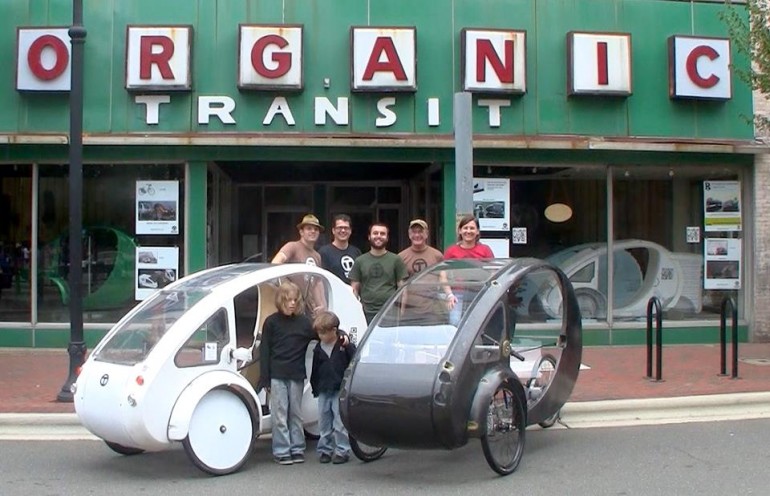 While currently operating out of a former furniture store in downtown Durham, they have ambitions not only to sell the ELF, and it’s stable-mate the TruckIt, but more globally, to set up micro-factories producing the ELF in “every downtown.” To-date they have had enquiries from many places, including Europe, and they are seriously looking into ways to supply markets further afield than the US.
While currently operating out of a former furniture store in downtown Durham, they have ambitions not only to sell the ELF, and it’s stable-mate the TruckIt, but more globally, to set up micro-factories producing the ELF in “every downtown.” To-date they have had enquiries from many places, including Europe, and they are seriously looking into ways to supply markets further afield than the US.
OT have followed the “Keep it simple” philosophy and are quite clear that they are not intending to compete with the more established, and more aerodynamic, velomobiles such as the Quest and the Mango. Their target is the thoroughly practical user who wants a highly visible vehicle with a large carrying capability and to whom speed is not a significant consideration. Hence the ELF is large – 8′ x 43″ x 5′ (2.4 x 1 x 1.5 m) and heavy – 100 lbs (45 kg).
To avoid the cost and complexity of suspension, OT have opted to use the standard MTB size of 26″ on all wheels, with large diameter tyres to smooth the ride. While simpler this does pose a concern as the front wheels will have to resist lateral forces not normally experienced by bicycle wheels and these forces are a function of the vehicle weight. The consensus so far on successful trikes and velomobiles has been to restrict the size of these wheels to not more than 20″.
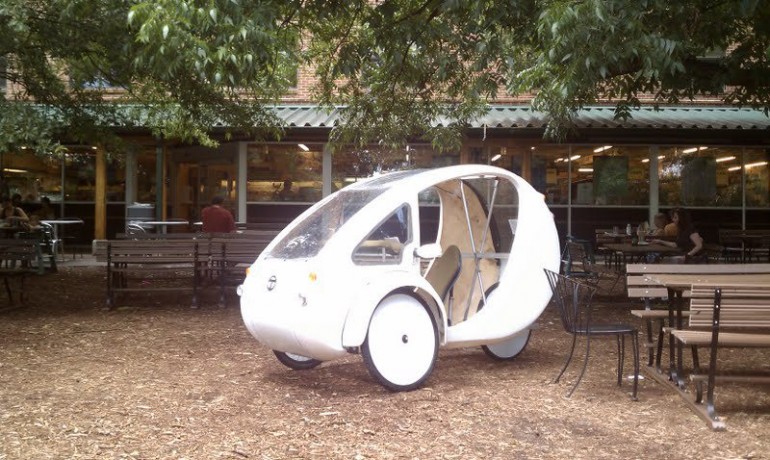 The purist will reject the reliance on electric assist and there has been some perhaps unfair criticism of the ELF’s weight, but this should not be an undue problem for the intended user. However, as there is reference to options to add: doors, floor and other extras; one can see the weight rising as the design begins to bloat. One nice feature is the integrated solar panels which allow the batteries to be trickle charged during the day, assuming access to adequate sunlight. Otherwise the standard battery pack takes two hours to charge.
The purist will reject the reliance on electric assist and there has been some perhaps unfair criticism of the ELF’s weight, but this should not be an undue problem for the intended user. However, as there is reference to options to add: doors, floor and other extras; one can see the weight rising as the design begins to bloat. One nice feature is the integrated solar panels which allow the batteries to be trickle charged during the day, assuming access to adequate sunlight. Otherwise the standard battery pack takes two hours to charge.
To conform to regulations, allowing the ELF to be classified as a bike, assisted top-speed is limited to 20 mph (32 km/h), but there is no reason why the rider can’t push the vehicle faster if they have the strength or gravity on their side. The following video is taken from an ELF driver’s eye view, about mid way through you hear a conversation between the ELF’s rider and a truck-driver about the potential speeds.
While the debate about “fast cycles” continues to rumble on, the current regulations, particularly those in Europe, that govern e-bikes and their classification impose relatively onerous requirements on vehicles that are classed as “more than a bike”. This makes it challenging to successfully develop and market a vehicle of this type. A recent article on the Low Tech Magazine blog, albeit featuring the highly aerodynamic WAW velomobile, argues the virtues of electric assisted velomobiles, much of which applies to the ELF, the second part of the article also goes into some of the issues with the current legislation.
One velomobile mentioned by the Low Tech article is the 55 kg Aerorider, developed in the mid 2000s. This vehicle with many similar attributes to the ELF failed to be commercially successful due to a combination of high cost, weight and the limitations imposed by regulation. It would be reasonable to say that if regulation had been favourable for a class of “fast bikes” the Aerorider would have done much better. As it stands the Aerorider was redesigned as the Sunrider which has now passed into the hands of Alligt, and Alligt are doing their part to lobby for a fast-bike class (snelfiets). As Alligt now have access to the moulds and tooling for the original Aerorider, should regulations change, one never knows, the Aerorider may ride again. Hopefully the ELF will continue to progress and, though lower cost, a different market and simplicity, be more successful than the Aerorider proved to be.


